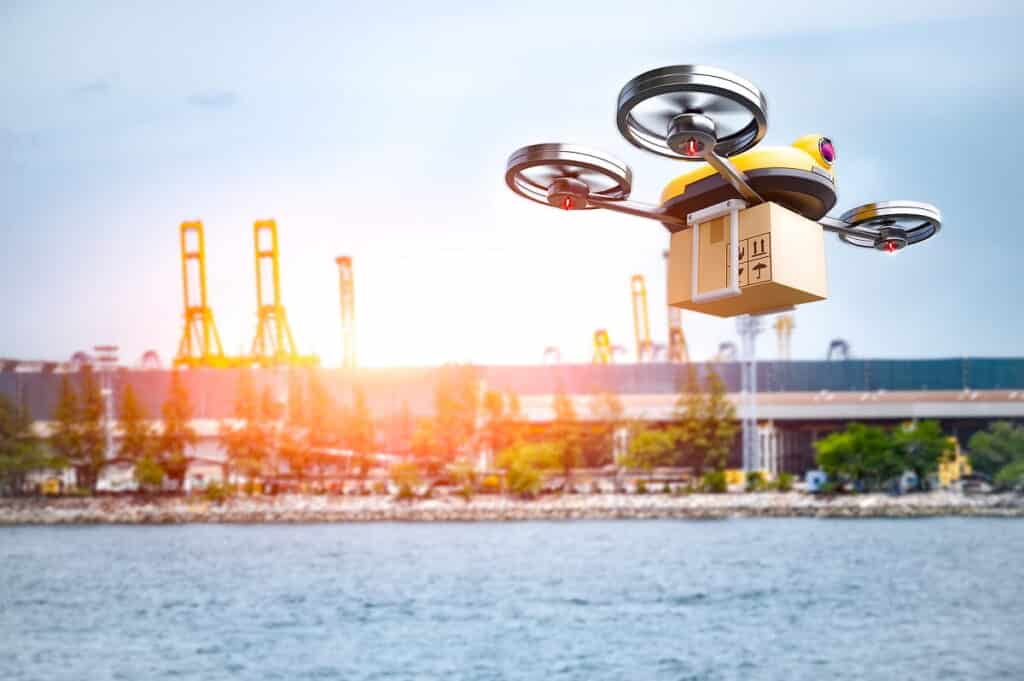A Stock for Underwater Robots, Spacesuits and Dark Rides
Table of contents

We often refer to the concept of “pure play” at Nanalyze when talking about investing in certain technologies. It simply means that we’re looking to bet on a company with a core product or service in one of the categories of emerging technologies that we cover like robotics or artificial intelligence. Pure plays are hard to come by in some of these categories. Sure, Google (GOOG) relies heavily on AI, but it does so much more that no one would consider it a pure play in AI. That leaves us with companies like AI chipmaker Nvidia (NVDA) (which has had a rough end to 2018, losing half its value in a couple of months) and a handful of other companies. Ditto for robotics, where pure play options are generally limited to companies building surgical robotic arms, industrial robots or exoskeletons. That’s why we got really excited when we came across a public company building something different – underwater robots.
You might say we rediscovered Oceaneering International (OII) last month at the SpaceCom Expo in Houston, where entrepreneurs building the new space economy gathered to connect and learn about the latest trends in their industry, like the building boom in spaceports. Oceaneering headlined a session on underwater robots at the two-day conference. The company operates a diverse fleet of what are called Remotely Operated Vehicles (ROVs), which it mainly uses to support the oil and gas industry. While we wouldn’t consider Oceaneering a pure play robotics stock – it designs spacesuits, builds “dark rides” for amusement parks, among a host of other products and services – its ROV business is a major contributor to its earnings:

In addition, Oceaneering is one of the top 10 holdings in the ROBO Global Robotics and Automation Index ETF (ROBO), which only includes companies in its portfolio that get a “distinct portion” of business revenue from robotics and automation. You’ll recall that Exchange Traded Funds (ETFs) are kind of like mutual funds but with lower fees, because they typically track a themed index, so there’s no egomaniacal fund manager trying to beat the market and lose your money. We recently revisited ROBO when we compared it against a new robotics ETF from iShares. Back in 2016, we even created our own robotics ETF using the Motif Investing platform based on the ROBO ETF, giving Oceaneering a 5% weight. So, let’s learn a bit more about what we are invested in.
Diving Into Oceaneering
Oceaneering International started way back in 1964 as a commercial dive company out of Louisiana called World Wide Divers, which eventually merged with a couple of other dive outfits to form Oceaneering International in 1969. The company eventually went public in 1978. Today, Houston-based Oceaneering does everything from developing ROVs and other robotics systems to building and maintaining deep-sea infrastructure to supporting industry operations at NASA’s Neutral Buoyancy Lab and designing life support systems for outer space. Oceaneering currently sits on a market cap of about $1.5 billion and employs about 8,000 people.
The company helped pioneer various diving technologies in its early years, including atmospheric diving suits that allow humans to dive hundreds of feet below the ocean surface without the physiological danger associated with those high-pressure depths. Oceaneering has also been involved in a number of headline-grabbing deep-sea recoveries. For example, its teams helped recover the solid rocket booster that was responsible for the 1986 Space Shuttle Challenger disaster. It has even assisted in archaeological excavations, such as the recovery of a Confederate submarine, and its ROVs helped with the investigation of a fraud case that involved blowing up a cargo vessel to hide evidence. In other words, these guys do some cool stuff.
Underwater Robots
And perhaps nothing is as cool as underwater robots. Oceaneering has a huge fleet of them: The company boasted 279 ROVs at the end of 2017, which it estimates represents about 28% of the industry’s work class underwater robots. Oceaneering also claims an estimated 60% market share of ROV services for oil drill support:

Its fleet of work class ROVs sounds like the lineup for the next Transformers movie or a line of men’s colognes. The heavy lifters include Nexxus, Maxximum, Millennium Plus, and Magnum Plus. There’s also a line of survey underwater robots with names like Omni Maxx, Sea Maxx, and Spectrum.

Tethered and remotely operated from the surface, the ROVs perform a variety of tasks in the oil and gas industry, including drill support, vessel-based inspection, maintenance and repair, installation and construction support, and pipeline inspection and surveys, among other services. The underwater robots are outfitted with manipulators, sonar and HD video cameras. Oceaneering also operates ROV pilot training centers in the United States, U.S., Norway, the U.K., Brazil, and Indonesia.
From Deep Sea to Spacesuits
Thirty years ago, the company created its Oceaneering Space Systems division, which leverages its expertise in deep-sea environments to the equally harsh environment of space. About 10 years ago, the division scored a major coup when NASA awarded it a contract worth up to $148 million to build a new spacesuit because the current ones are way out of style. While Oceaneering ended up getting about $136 million, the space agency canceled the contract a couple of years ago, and a subsequent audit found that the project had mostly been a waste of money, Ars Technica reported. That still leaves NASA without a reliable wardrobe for its future astronauts. Probably the most interesting thing that we learned is that there is actually a spacesuit market – we’re not making this up – and several fly-by-night market intelligence companies have produced market reports talking about how much growth there is in this “space.”
A Ride on the Dark Side
While Oceaneering may have had some ups and downs on the NASA spacesuit contract, the company still knows how to have fun. The Oceaneering Entertainment Systems division develops all sorts of technology for theme parks and other entertainment venues. The company has made a particular name for itself in designing dark rides, which has nothing to do with illegal sex acts advertised on the Dark Web, as we had initially hoped. Dark ride vehicles are specially designed to take people on a guided tour through different amusement park experiences, such as “Transformers: The Ride” at Universal Studios in Florida.
Most systems rely on a tracked guidance system, but Oceaneering also has a trackless vehicle called Revolution that looks tailormade for a Pirates of the Caribbean ride. Revolution relies on the company’s Automated Guided Vehicle (AGV) technologies. Oceaneering doesn’t specifically say how its AGV technology works, but generally, these sorts of robots follow markers or wires in the floor or use computer vision, magnets, or lasers for navigation. The company also manufactures a line of industrial robots for materials handling that also employ AGV technologies. And just last month, the company introduced an electric mass transit vehicle for amusement parks that it developed with a company out of the Netherlands called 2getthere. In the case of he REVO-GT, it navigates based on predefined routes.
Financials: End of the Ride
Well, that was fun, but the ride is over. Let’s talk a bit about the financials for Oceaneering:

If you were paying attention back in 2012 or 2013, you would have found analysts were quite bullish on the company – and for good reason. At that time, over the last 10 years, it had been able to grow its earnings at an annual rate of 20%. The stock sat at a price of about $5 a share around 2003. By October 2013, it had peaked at more than $86 a share, with a market cap of about $8.5 billion and offered a 15-cent-per-share quarterly dividend. Fast forward to today and the stock is trading at around $15 with a market cap of about $1.5 billion. Last year, the company eliminated its dividend until further notice, which is never a good sign. You can see its rise and fall in more detail here:
Analysts were previously singing the praises of Oceaneering, in part, because it had a diversified business that seemed indifferent to the fluctuating oil market. But it’s been a different story over the last five years, as the offshore oil market suffered while shale fields in Texas, Colorado and elsewhere have boomed. The prognosticators now say the offshore oil market has finally bottomed out and should start to recover. However, Oceaneering predicts it will continue to operate in choppy waters for the foreseeable future, and the company posted a $66 million net loss in the quarter that ends in September, with $519 million in revenue. That’s double the losses from the previous quarter at $33 million on $479 million in revenue. Its ROV services have been on a steady decline, as well, illustrating its reliance on that part of its business for profit:
The company’s underwater robot fleet is being used more this year, but average revenue per day is down because the boost in activity is taking places in geographic regions where the day rates are lower. Overall, the average hire rate of an ROV is $7,900 per day. That’s a small price to pay when equipment failures could cost a rig $1 million per day in losses.
Conclusion
Oceaneering is an interesting technology stock, offering some real exposure to the robotics market, but at the end of the day, it’s also an energy stock, with all of the volatility that accompanies that sector. If you’re invested in the ROBO ETF or another robotics-themed fund that includes Oceaneering in its portfolio, that’s probably the most exposure to Oceaneering that you want at this time.
Sign up to our newsletter to get more of our great research delivered straight to your inbox!
Nanalyze Weekly includes useful insights written by our team of underpaid MBAs, research on new disruptive technology stocks flying under the radar, and summaries of our recent research. Always 100% free.
















